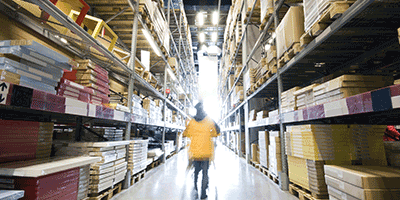In this article, Rebecca Scottorn, Tom Diplock, Jeremy Wheatland, Harpreet Singh and Geoff Parkin at L.E.K. Consulting reflect on trends impacting the UK building products sector, especially in the residential and light commercial sectors.
At the start of last year, we reflected on current market trends we were observing through working with corporates and investors in the building products industry. We have outlined seven key themes in the residential and commercial sectors and welcome perspectives on how various stakeholders see the outlook for 2022.
Strong recovery in residential markets
Given the strong rebound in the UK’s economy, high levels of consumer savings and an uncertain recovery in travel, consumers have continued to divert spend towards their homes, thus the demand for building products has held strong. Lockdowns drove high levels of do-it-yourself/home improvement and, whilst we hope the sort of restrictions seen early in 2021 are behind us, home improvement projects are continuing, driven by a permanent increase in work-from-home behaviour (albeit levels to be determined) and a related increased focus on the home environment. Furthermore, larger-ticket projects that had been put off during lockdown ― due to labour shortages, Covid-19 factors (e.g. contact with tradespeople) and uncertainty about the economic environment ― are now taking place.
Housing transactions are a major trigger for spend on building products and refurbishments, and have provided further market tailwinds this year. Estate agents report continued strong demand for more space, with UK property transactions exceeding 160,000 in September 2021, with seasonally adjusted transactions up 68% from the corresponding month in 2020, according to the latest HMRC data. This was despite the nil rate band for Stamp Duty Land Tax in England and Northern Ireland falling from £500,000 to £250,000 on 1 July 2021, where it remained until 30 September, before returning to the standard amount of £125,000. While the stamp duty holiday has undoubtedly driven a spike in transactions this year, latest forecasts suggest a stabilisation above 2019 levels for the next few years.
Housebuilders are also seeing that levels of demand and housing starts are back to 2019 levels, with further growth expected next year supported by the ongoing UK housing shortage and sustained house price growth. The UK government’s £1.8 billion pledge for brownfield housing, in addition to the £10 billion already committed for housing over a five-year period, will provide ongoing stimulus.
While underlying demand has recovered strongly this year, this follows several years of depressed activity in the residential repair, maintenance and improvement (RMI) market due to reduced consumer confidence following the Brexit vote in 2016, leading to a backlog of deferred work. Labour and material shortages (see points 3 and 4) have further delayed projects this year, and deferred demand should help sustain activity levels well into 2022 and beyond.
Rapid acceleration of digital/ecommerce
The rapid growth of digital and ecommerce accelerated by Covid-19 looks set to continue, transforming the buying process for trade and end customers (from pre-purchase research to aftermarket service). We conducted our latest proprietary contractor survey over the summer to understand tradespeople’s channel behaviours across Europe.
While the full results will be out in the next few weeks, the survey clearly highlights how Covid-19 has accelerated adoption of online channels for ordering and delivery. Interestingly, respondents expect the shift from ‘collect’ to ‘delivered’ to partially unwind; however, online ordering is expected to continue to increase. The survey also notes the continued rise of Amazon as a channel for building products as well as a growing younger workforce that does extensive online research for building products.
For building product companies, these trends require development of a holistic digital strategy covering online brand presence, robust product data, online product availability and pricing, and an approach to Amazon and broader channel relationships.
Supply chain and raw material pricing pressure
Key building materials, including bagged cement, concrete roof tiles, timber, steel and bricks, have been in short supply across the UK. Lorry driver shortages are also contributing to delivery delays. Cement shortages eased somewhat over the summer as supplies were imported from abroad, but lead times are anticipated to remain long until year end. Contractors have been struggling with lead times of 24 to 30 weeks for concrete tiles.
Price inflation across material and product categories continues to be a major theme of 2021. Construction material costs were up around 20% for the year up to the end of July, according to data from the Department of Business, Energy & Industrial Strategy, with some categories (e.g. timber) more than doubling in price this year. While prices have begun to stabilise or correct in recent weeks, rising gas prices may also influence pricing going forward. There is mixed ability to pass through costs to customers, with challenges relating to channel management and handling of commercial agreements. For companies that have managed to pass through material prices, sustainability of those pricing levels and continued ability to pass on any further price increases are critical questions. Successful businesses are actively working with their customers, with a good understanding of the different segments and their relative price elasticity, and developing more resilient supply chains to mitigate supply risk.
Labour shortages and logistics challenges
One of the key differences vs our last article is the scale of the challenges due to labour shortages and logistics challenges.
Whilst the sector made good use of the furlough scheme, 2021’s continued high Covid-19 rates and the ‘pingdemic’ had a severe impact on the availability of workforce. In addition, travel restrictions and the impact of Brexit have reduced the UK’s ability to infill gaps with European labour.
The broader construction sector is facing longer-term challenges too, including attracting and retaining talent and how to adapt to changing expectations, e.g. flexible working.
The extent of disruption to logistics is becoming clear across all sectors. Heavy goods vehicle (HGV) driver shortages have been exacerbated by Brexit, travel restrictions and Covid-19 slowing down licence approvals.
Beyond tactically managing the short-term disruptions, construction firms need to think about greater usage of technology (e.g. modern methods of construction [MMC]) to reduce labour content and adapt their strategies to a younger, less experienced workforce. These factors also have implications for building product suppliers. On the former, changing build methods will impact customer requirements for product specification and delivery. On the latter, our 2021 proprietary contractor survey establishes that younger tradespeople undertake more frequent online research and use multiple information sources (e.g. YouTube) ― providing product suppliers an opportunity to develop brand affinity and high customer lifetime value.
Uneven recovery in commercial sectors
The commercial sector has been significantly impacted by closures and low confidence in retail. According to the latest Experian forecasts, commercial output at the end of 2023 is still expected to be 5% lower than in 2019 in real terms, despite three years of growth. However, the recovery for hospitality has been stronger and is gaining momentum.
The beginning of the year saw a rise in commercial activity as companies undertook office remodelling and refit work in preparation for workers to return to the office in a socially distant manner. This was also the case in retail and leisure, where refurbishing and repurposing space helped businesses prepare as social distancing restrictions were eased. However, uncertainty around demand for offices and hotels continues to impact refit and early-stage new-build pipelines, particularly in London.
Warehousing, distribution and logistics continue to be the strongest performing sector on the back of localisation of supply chains and the shift to online shopping, which is largely holding at higher levels of penetration. This raises significant questions over the future of land use in town centres (see point 6).
Businesses exposed to commercial sectors need to actively monitor how these trends evolve in the next few years and adapt their market participation to minimise long-term disruptions.
Changing land use of high streets and town centres
Covid-19 accelerated the decline of high streets and town centres, which had already been suffering due to the increased adoption of online shopping. Shopping centres have fared better than many high streets, although a continuation of this trend is unclear. The pandemic also made working from home and online meetings the norm. With fewer people visiting cities and towns to work and shop, this has left a void in areas once characterised by bustling offices and shops.
High street recovery, particularly in larger cities and towns, is now dependent largely on workers returning to the office, replenishing demand for local services. However, this may never reach pre-pandemic levels as the right to request flexible working becomes commonplace. Cities and towns will therefore need support to rethink the purpose of their centres, with the ‘15 minute city’ concept that creates environments that mix places for work, living and recreation beginning to gain traction.
Office space will need to be transformed to harness collaboration and creativity, with less space devoted to tasks that could be undertaken remotely. Therefore, a rise in town centre remodelling is anticipated as sites are remodelled for post-pandemic working. Businesses need to seek out opportunities to participate in this expected wave.
Sustainability matters
Sustainability issues continue to be critical in boardrooms, with increasing stakeholder pressures from investors, customers, end consumers, regulatory bodies, supply chain partners, competitors and employees. A growing number of customers are pressuring construction companies to design and build more eco-friendly structures, in particular in the public sector. As demand builds, investors are questioning traditional construction methods and materials and pushing for more sustainable business practices. In conjunction with labour shortages, sustainability factors are driving further innovation in MMC.
Sustainability for building products can refer to the materials used (resource intensity, sustainable sourcing, use of recycled materials), manufacturing processes (water, carbon, energy), distribution and logistics, construction processes (e.g. energy efficiency, waste), sustainability whilst in use, and end-of-life considerations.
The emissions caused by buildings (both embedded and through operations) are also coming under increased scrutiny. The UK government finally published its heat and buildings strategy in October, and while this doesn’t provide the concrete targets that some were hoping for, it does give a good outline of the government’s direction of travel on the path to net zero buildings.
Challenges come when the decision-making process is complex and stakeholders are fragmented ― e.g. with price often still being prioritised. As the cost of building products continues to rise, construction companies need to plan and manage projects using cost-effective raw materials while ensuring that workers and heavy machinery are not sitting idle. If sustainable products are too expensive, project leaders may choose not to use them. Therefore, lowering the cost of sustainable products would make a significant difference in helping all stakeholders meet their sustainability goals.
The way ahead
2021 has been a year of significant uncertainty for the building products sector, but also includes some real bright spots and growth opportunities. Though materials and labour shortages have had a significant impact, the economic rebound has been strong and demand fundamentals remain positive going into 2022.
Given that the outlook for demand is uncertain, and likely to be uneven across segments, scenario planning may help companies navigate this, considering upside and downside potential and the appropriate commercial and operational responses.
What is still certain is that the winners in the building products sector will be those companies that focus on:
- Operational agility, to capture growth opportunities in light of ongoing operational challenges and an evolving marketplace
- Ramping up digital capability ― both in customer-facing online channels to build brand awareness and in supporting B2B relationships, helping distribution partners improve digital effectiveness
- Getting ahead of the sustainability agenda
We look forward to your perspectives on what is in store for the building products sector in 2022.



